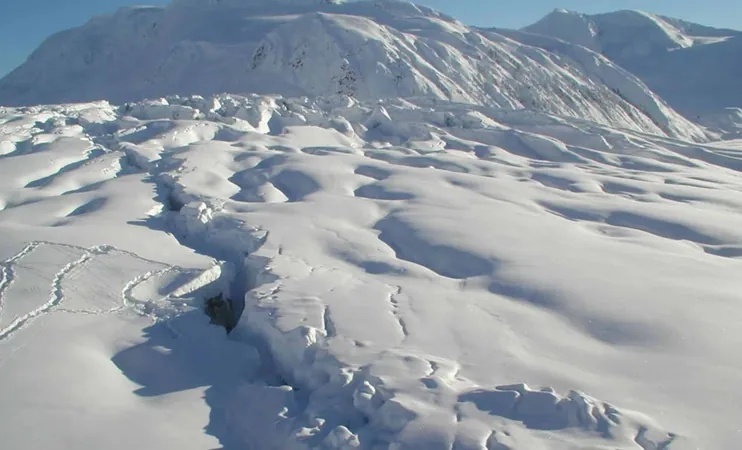
Unraveling Alaska's 620-Mile Geological Enigma: The Denali Fault's Secrets Exposed!
2025-01-02
Author: Kai
The Epic Tectonic Journey
The Denali Fault extends over 1,200 miles, traversing both Alaska and Canada’s Yukon Territory. Its intricacies have attracted scientists eager to decode the geological processes that have sculpted North America's lithosphere. The mystery of the Clearwater Mountains, Kluane Lake, and Coast Mountains has finally been solved: these regions were once part of a unified terminal suture zone created between 72 and 56 million years ago, marking the conclusive integration of the ancient Wrangellia Composite Terrane—an oceanic plate—into North America.
Over the eons, tectonic forces shifted the fault, splintering this suture zone and scattering its remnants across an expansive area. “Our understanding of lithospheric growth along the western margin of North America is becoming clearer,” Regan explained. “Reconstructing strike-slip faults like the Denali Fault is a significant part of that clarity.”
Inverted Metamorphism: A Geological Paradox
Among the findings that connect these regions is the phenomenon known as inverted metamorphism. In typical geological formations, rocks formed under elevated temperatures and pressures are found deeper within the Earth, while those created under cooler conditions are nearer to the surface. In the case of the Denali Fault, the sequence is reversed—rock types that originated at greater depths now sit atop those produced under lower-pressure conditions.
Regan highlighted a compelling aspect of this research: “We discovered that each of the three inverted metamorphic belts formed concurrently under similar conditions. Not only do they share an age, but their geological behavior is strikingly alike.” By analyzing monazite—a mineral rich in rare earth elements—the team was able to trace the geological evolution of each site, confirming their shared history.
Understanding the Denali Fault's Tremors
The implications of the Denali Fault stretch beyond its intricate geological history. As one of the major strike-slip faults in the region, it remains active and dangerous, with the potential to generate substantial earthquakes. Grasping its history is vital for understanding the tectonic forces that continue to shape Alaska’s dramatic landscape.
Moreover, the fault acts as a natural laboratory for platelet studies. It provides invaluable insights into how distant landmasses are integrated into larger continental plates, thereby contributing to our understanding of continental evolution and reshaping over geological timescales.
A Long Road to Discovery
This groundbreaking research is the culmination of decades of geological exploration. A pivotal study in 1993 by scientists from the University of Alberta and the University of British Columbia hinted at the similarities among the Denali Fault sites but fell short of recognizing their unified nature. Regan, who kept that 1993 paper displayed prominently on his wall for inspiration, believes it was ahead of its time.
By combining modern techniques with historical insights, Regan and his team have woven together a comprehensive narrative detailing the fault's history. Their ability to link data across multiple regions offers a clearer picture of the geological puzzle.
A Paradigm Shift in Geological Science
The findings surrounding the Denali Fault promise to reshape our comprehension of plate tectonics and lithospheric growth. By pinpointing the suture zone that joined the Wrangellia Composite Terrane to North America, Regan's research illuminates the processes that create and transform continents.
This study also emphasizes the necessity of collaborative and interdisciplinary approaches in unraveling complex geological puzzles. The integration of field studies, mineral analysis, and tectonic modeling creates a robust framework for investigating other fault systems worldwide.
Sean Regan poignantly stated, “The connections are only made when we can reconstruct the deformation along the Denali Fault.” This research serves as a reminder of the dynamic forces that continue to shape our planet beneath our feet, unveiling a story waiting for more revelations in the geological realm.
Stay tuned as new discoveries could redefine our understanding of Earth's tectonic past!

 Brasil (PT)
Brasil (PT)
 Canada (EN)
Canada (EN)
 Chile (ES)
Chile (ES)
 Česko (CS)
Česko (CS)
 대한민국 (KO)
대한민국 (KO)
 España (ES)
España (ES)
 France (FR)
France (FR)
 Hong Kong (EN)
Hong Kong (EN)
 Italia (IT)
Italia (IT)
 日本 (JA)
日本 (JA)
 Magyarország (HU)
Magyarország (HU)
 Norge (NO)
Norge (NO)
 Polska (PL)
Polska (PL)
 Schweiz (DE)
Schweiz (DE)
 Singapore (EN)
Singapore (EN)
 Sverige (SV)
Sverige (SV)
 Suomi (FI)
Suomi (FI)
 Türkiye (TR)
Türkiye (TR)
 الإمارات العربية المتحدة (AR)
الإمارات العربية المتحدة (AR)